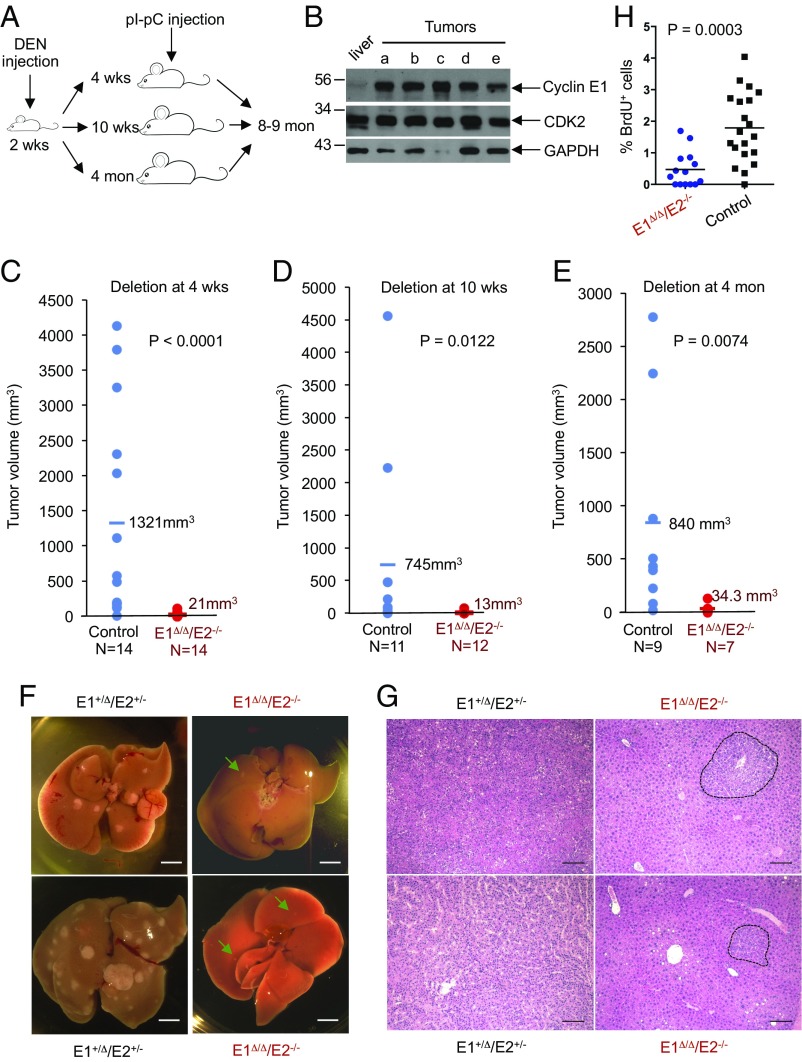Fig. 1.
E-type cyclins are required for liver cancer progression. (A) Experimental outline. Diethylnitrosamine (DEN) was used to trigger development of hepatocellular carcinoma; injection of polyinosinic–polycytidylic acid (pI–pC) was used to induce Cre recombinase and delete E-type cyclins. Male mice of the following genotypes were used: cyclin E1+/FE2+/−/Mx1-Cre (control) and cyclin E1F/FE2−/−/Mx1-Cre (experimental). (B) Western blot analysis of cyclin E1 levels in five liver tumors (a–e) collected from DEN-injected 8-mo-old mice. For comparison, normal liver was also analyzed. Note that cyclin E level is very low in normal liver but quite high in liver tumors. (C) The estimated tumor burden (per mouse) in control cyclin E1+/ΔE2+/−/Mx1-Cre and in cyclin E1Δ/ΔE2−/−/Mx1-Cre (cyclin E-deleted) mice, 8–9 mo after DEN injection. Mice were injected with pI–pC (to delete cyclin E) at 4 wk of age. Each dot corresponds to an individual mouse; horizontal lines depict mean values. (D) Similar analysis as in C, except that cyclin E was deleted at 10 wk. (E) Similar analysis as in C, cyclin E deletion at 4 mo. In C–E, P values were calculated using Kolmogorov–Smirnov test. (F) Representative images of livers with tumors in control cyclin E1+/ΔE2+/−/Mx1-Cre and in cyclin E-deleted (cyclin E1Δ/ΔE2−/−/Mx1-Cre) mice, 8 mo after DEN injection. Cyclin E was deleted (through pI–pC administration) at 4 mo. Green arrows point to small tumors in cyclin E-deleted mice. (Scale bar, 10 mm.) (G) Sections of livers with tumors, as in F, stained with hematoxylin and eosin. In sections from cyclin E1+/ΔE2+/−/Mx1-Cre livers, tumors occupy the entire field of view; dashed lines indicate boundaries of small tumors in cyclin E1Δ/ΔE2−/−/Mx1-Cre mice. (Scale bar, 100 μm.) (H) Quantification of BrdU-positive cells in sections of liver tumors from cyclin E1+/ΔE2+/−/Mx1-Cre (control, 20 tumors from four mice) and cyclin E-deleted (E1Δ/ΔE2−/−/Mx1-Cre mice; 14 tumors from four mice). Mice were injected with pI–pC three times at 4 mo after DEN injection and killed 7 d after the last pI–pC dose. P value was calculated using two-tailed t test.

